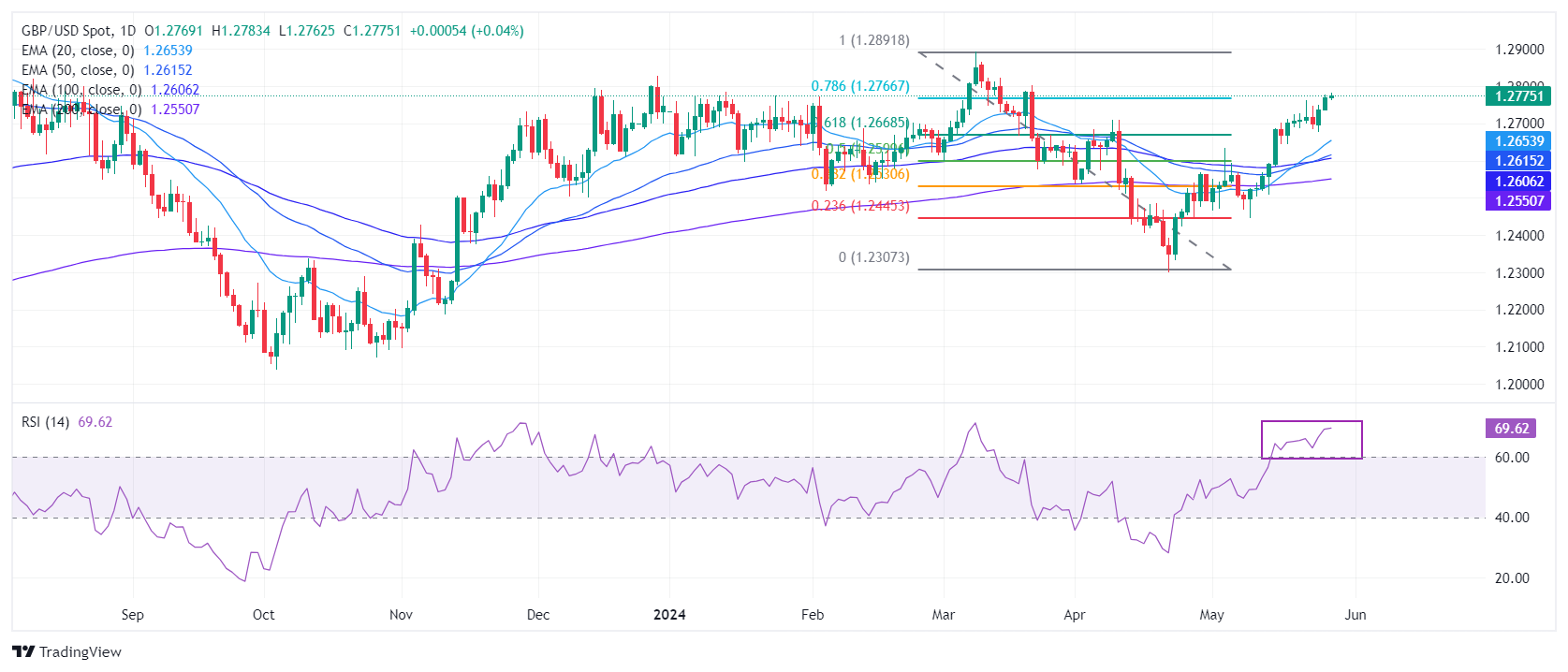Pound Sterling outperforms the US Dollar with focus on US core PCE inflation

- The Pound Sterling jumps to 1.2780 as the US Dollar declines with eyes on US core PCE inflation data.
- US core PCE inflation is forecasted to have grown at a steady pace on a monthly and an annual basis.
- A slower decline in the UK inflation in April diminished BoE rate-cut prospects.
The Pound Sterling (GBP) approaches the round-level resistance of 1.2800 in Tuesday’s European session. The strength in the GBP/USD pair is driven by the upbeat Pound Sterling, which capitalizes on risk-on sentiment and deepening uncertainty about when the Bank of England (BoE) will start reducing interest rates.
Earlier, investors expected the BoE to start reducing interest rates from the June meeting. Firm speculation for BoE rate cuts was built on expectations that the United Kingdom’s annual headline inflation will return to the desired rate of 2% in April. BoE Governor Andrew Bailey said in an event organised by the International Monetary Fund (IMF) in Washington on April 16 that “inflation in the UK will fall near its 2% target next month” and “has declined roughly in step with the BoE’s forecast in February”, Bloomberg reported.
However, the pace at which the underlying inflation declined was insufficient to drag price pressures to the 2% target, and it softened to 2.3%. Apart from a slower decline in headline inflation, stubborn service inflation appears to be a major barrier that is making the last mile for price pressures towards the 2% target extremely stubborn.
Daily digest market movers: Pound Sterling rises as US Dollar remains under pressure
- The Pound Sterling advances to 1.2780 against the US Dollar as the latter is under pressure due to investors’ higher risk appetite. The appeal for risk-perceived assets has strengthened even though investors’ expectations for the Federal Reserve (Fed) reducing interest rates from the September meeting have diminished significantly.
- The CME FedWatch tool shows that traders see a roughly 50% chance of the Fed maintaining the current monetary policy framework in September. The odds of keeping rates unchanged have increased from 34% recorded a week ago. This could trigger a bullish reversal move in the US Dollar, which has been facing significant selling pressure since Friday. The US Dollar Index (DXY), which tracks the Greenback’s value against six major currencies, has posted a fresh weekly low near 104.40.
- Traders have pared Fed rate-cut bets as officials have reiterated that the current interest rate framework is sufficiently restrictive and needs to be held for a longer period until they are assured that inflation will sustainably return to the 2% target before considering rate cuts. Fed policymakers want to see price pressures declining for months to get that kind of confidence.
- Going forward, investors will focus on the United States (US) core Personal Consumption Expenditure Price Index (PCE) data for May, which will be published on Friday. The core PCE inflation data, which is the Fed’s preferred inflation measure, will provide fresh cues over the inflation outlook.
- Economists expect monthly and annual core PCE inflation to grow steadily by 0.3% and 2.8%, respectively. A hotter-than-expected inflation reading will be favorable for the US Dollar as it will force traders to pare dovish bets for September, while soft figures will do the opposite.
Technical Analysis: Pound Sterling aims to recapture 1.2800
The Pound Sterling extends its upside to 1.2780 against the US Dollar. The GBP/USD pair aims to recapture the round-level resistance of 1.2800. The appeal for the Cable strengthens as it reaches the 78.6% Fibonacci retracement (plotted from the March 8 high of 1.2900 to the April 22 low at 1.2300) at 1.2770.
The Cable is expected to remain bullish as all short-to-long-term Exponential Moving Averages (EMAs) are sloping higher, suggesting a strong uptrend.
The 14-period Relative Strength Index (RSI) has shifted into the bullish range of 60.00-80.00, suggesting that the momentum has leaned toward the upside.
Economic Indicator
Core Personal Consumption Expenditures – Price Index (YoY)
The Core Personal Consumption Expenditures (PCE), released by the US Bureau of Economic Analysis on a monthly basis, measures the changes in the prices of goods and services purchased by consumers in the United States (US). The PCE Price Index is also the Federal Reserve’s (Fed) preferred gauge of inflation. The YoY reading compares the prices of goods in the reference month to the same month a year earlier. The core reading excludes the so-called more volatile food and energy components to give a more accurate measurement of price pressures.” Generally, a high reading is bullish for the US Dollar (USD), while a low reading is bearish.
